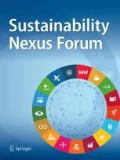Abstract
Due to the rising demand for natural resources and a decreasing supply, an efficient resource use is necessary. To evaluate resource efficiency, especially at the enterprise level, indicators are needed. In this paper, a literature review on resource efficiency indicators in terms of life cycle assessment has been conducted. As a result, we developed a framework for a systematization of existing resource use indicators.




Literatur
Bach V, Schneider L, Berger M, Finkbeiner M (2014) Methoden und Indikatoren zur Messung von Ressourceneffizienz im Kontext der Nachhaltigkeit. In: Thomé-Kozmiensky KJ, Goldmann D (Hrsg) Recycling und Rohstoffe. TK-Verl., Neuruppin, S 87–101
Bösch ME, Hellweg S, Huijbregts MAJ, Frischknecht R (2007) Applying cumulative exergy demand (CExD) indicators to the ecoinvent database. Int J Life Cycle Assess 12:181–190. doi:10.1065/lca2006.11.282
Brich S (Hrsg) (2014) Gabler Wirtschaftslexikon. Springer Gabler, Wiesbaden
Deutsche Institut für Normung e.V. (2006) Umweltmanagement – Ökobilanz – Grundsätze und Rahmenbedingungen. Deutsche Institut für Normung e.V., Beuth Verlag, Berlin
Dewulf J, Benini L, Mancini L, Sala S, Blengini GA, Ardente F, Recchioni M, Maes J, Pant R, Pennington D (2015) Rethinking the area of protection “natural resources” in life cycle assessment. Environ Sci Technol 49:5310–5317. doi:10.1021/acs.est.5b00734
Dewulf J, Bösch ME, Meester BD, Vorst G van der, Langenhove H van, Hellweg S, Huijbregts MAJ (2007) Cumulative exergy extraction from the Natural Environment (CEENE); A comprehensive Life Cycle Impact Assessment method for resource accounting. Environ Sci Technol 41:8477–8483. doi:10.1021/es0711415
Drielsma JA, Russell-Vaccari AJ, Drnek T, Brady T, Weihed P, Mistry M, Simbor LP (2016) Mineral resources in life cycle impact assessment – defining the path forward. Int J Life Cycle Assess 21(1):85–105. doi:10.1007/s11367-015-0991-7
Europäische Kommission (2005) Mitteilung der Kommission an den Rat, das Europäische Parlament, den Europäischen Wirtschafts- und Sozialausschuss und den Ausschuss der Regionen: Thematische Strategie für eine nachhaltige Nutzung natürlicher Ressourcen; KOM(2005)670.
Europäische Kommission (2011) Mitteilung der Kommission an den Rat, das Europäische Parlament, den Europäischen Wirtschafts- und Sozialausschuss und den Ausschuss der Regionen: Fahrplan für ein ressourcenschonendes Europa; KOM(2011)571.
Eurostat (2001) Economy-wide material flow accounts and derived indicators; A methodological guide. Office for Official Publications of the European Communities, Luxembourg
Fink A (2014) Conducting research literature reviews; From the internet to paper. SAGE, Los Angeles.
Frischknecht R, Büsser Knöpfel S (2013) Ökofaktoren Schweiz 2013 gemäss der Methode der ökologischen Knappheit; Methodische Grundlagen und Anwendung auf die Schweiz. Bundesamt für Umwelt, Bern
Giljum S, Burger E, Hinterberger F, Lutter S, Bruckner M (2011) A comprehensive set of resource use indicators from the micro to the macro level. Resour Conserv Recy 55:300–308. doi:10.1016/j.resconrec.2010.09.009
Goedkoop M, Heijungs R, Huijbregts M, Schryver A De, Struijs J, Zelm R van (2013) ReCiPe 2008; A life cycle impact assessment method which comprises harmonised category indicators at the midpoint and the endpoint level. Ministerie van VROM, Den Haag
Goedkoop M, Spriensma R (2000) The Eco-indicator 99; A damage oriented method for Life Cycle Impact Assessment. PRé Consultants, Amersfoort
Guinée JB, Heijungs R (1995) A proposal for the definition of resource equivalency factors for use in product life-cycle assessment. Environ Toxicol Chem 14:917–925. doi:10.1002/etc.5620140525
Huijbregts M (2010) Cumulative energy demand as predictor for the environmental burden of commodity production. Environ Sci Technol 44:2189–2196. doi:10.1021/es902870s
Humbert S, Schryver A De, Bengoa X, Margni M, Jolliet O (2012) IMPACT 2002+; User Guide. Quantis, Lausanne
Huysman S, Sala S, Mancini L, Ardente F, Alvarenga RA, Meester S de, Mathieux F, Dewulf J (2015) Toward a systematized framework for resource efficiency indicators. Resour Conserv Recy 95:68–76. doi:10.1016/j.resconrec.2014.10.014
Potting J, Hauschild M (2005) Spatial differentiation in LCA impact assessment; The EDIP2003 methodology. Environmental Protection Agency, Kopenhagen
Ritthoff M, Rohn H, Liedtke C (2002) Calculating MIPS; Resource productivity of products and services. Wuppertal Institute, Wuppertal
Rugani B, Huijbregts MAJ, Mutel C, Bastianoni S, Hellweg S (2011) Solar energy demand (SED) of commodity life cycles. Environ Sci Technol 45:5426–5433. doi:10.1021/es103537f
Schmidt M (2014) Zu den Schutzzielen der Ressourceneffizienz. uwf 22:147–152. doi:10.1007/s00550-014-0337-0
Schneider L (2011) The anthropogenic stock extended abiotic depletion potential (AADP) as a new parameterisation to model the depletion of abiotic resources. Int J Life Cycle Assess 16:929–936. doi:10.1007/s11367-011-0313-7
Schneider L (2014) The economic resource scarcity potential (ESP) for evaluating resource use based on life cycle assessment. Int J Life Cycle Assess 19:601–610. doi:10.1007/s11367-013-0666-1
Steen B (1999) A systematic approach to environmental priority strategies in product development (EPS); Version 2000 – Models and data of the default method. Centre for Environmental Assessment of Products and Material Systems, Göteborg
Umweltbundesamt (2012) Glossar zum Ressourcenschutz. Dessau
Umweltbundesamt (2015) Deutsches Ressourceneffizienzprogramm (ProgRess); Programm zur nachaltigen Nutzung und zum Schutz der natürlichen Ressourcen. Berlin
Vadenbo C, Rørbech J, Haupt M, Frischknecht R (2014) Abiotic resources: New impact assessment approaches in view of resource efficiency and resource criticality – 55th Discussion Forum on Life Cycle Assessment, Zurich, Switzerland, April 11, 2014. Int J Life Cycle Assess 19(10):1686–1692. doi:10.1007/s11367-014-0784-4
Verein Deutscher Ingenieure e. V. (2014) Ressourceneffizienz: Methodische Grundlagen, Prinzipien und Strategien. VDI 4800 Blatt 1. Verein Deutscher Ingenieure e. V., Düsseldorf.
Author information
Authors and Affiliations
Corresponding author
Rights and permissions
About this article
Cite this article
Thonemann, N., Schumann, M. Ressourceneffizienz in der Ökobilanz. uwf 24, 69–74 (2016). https://doi.org/10.1007/s00550-016-0386-7
Published:
Issue Date:
DOI: https://doi.org/10.1007/s00550-016-0386-7

